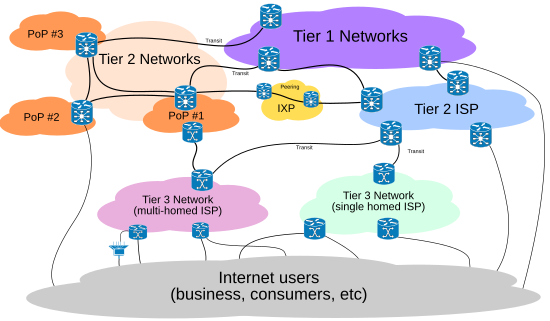A Tier 1 network is an Internet Protocol (IP) network that can reach every other network on the Internet solely via settlement-free interconnection (also known as settlement-free peering).[1][2] Tier 1 networks can exchange traffic with other Tier 1 networks without paying any fees for the exchange of traffic in either direction.[3] In contrast, some Tier 2 networks and all Tier 3 networks must pay to transmit traffic on other networks.[3]

There is no authority that defines tiers of networks participating in the Internet.[1] The most common and well-accepted definition of a Tier 1 network is a network that can reach every other network on the Internet without purchasing IP transit or paying for peering.[2] By this definition, a Tier 1 network must be a transit-free network (purchases no transit) that peers for no charge with every other Tier 1 network[4][5] and can reach all major networks on the Internet. Not all transit-free networks are Tier 1 networks, as it is possible to become transit-free by paying for peering, and it is also possible to be transit-free without being able to reach all major networks on the Internet.
The most widely quoted source for identifying Tier 1 networks is published by Renesys Corporation, but the base information to prove the claim is publicly accessible from many locations, such as the RIPE RIS database,[6] the Oregon Route Views servers, Packet Clearing House, and others.
It can be difficult to determine whether a network is paying for peering or transit, as these business agreements are rarely public information, or are covered under a non-disclosure agreement. The Internet peering community is roughly the set of peering coordinators present at the Internet exchange points on more than one continent. The subset representing Tier 1 networks is collectively understood in a loose sense, but not published as such..
Common definitions of Tier 2 and Tier 3 networks:
- Tier 2 network: A network that peers for no charge with some networks, but still purchases IP transit or pays for peering to reach at least some portion of the Internet.
- Tier 3 network: A network that solely purchases transit/peering from other networks to participate in the Internet.
- ^ a b Winther, Mark (May 2006). "Tier1 ISPs: What They Are and Why They Are Important" (PDF). NTT America Corporate. Archived from the original (PDF) on 2010-08-03.
- ^ a b "How the 'Net works: an introduction to peering and transit: Page 4". 2008-09-02. Retrieved 2008-11-04.
Tier 1 networks are those networks that don't pay any other network for transit yet still can reach all networks connected to the internet.
- ^ a b "Definition of: Tier 1 network". pcmag.com. Retrieved 2018-08-10.
- ^ Hundley, Kent (31 August 2009). Alcatel-Lucent Scalable IP Networks Self-Study Guide: Preparing for the Network Routing Specialist I (NRS 1) Certification Exam. John Wiley & Sons. ISBN 978-0-470-52938-6.
- ^ Norton, William B. (8 August 2011). The Internet Peering Playbook: Connecting to the Core of the Internet. DrPeering Press. ISBN 978-1-937451-02-8.
- ^ RIPE RIS database